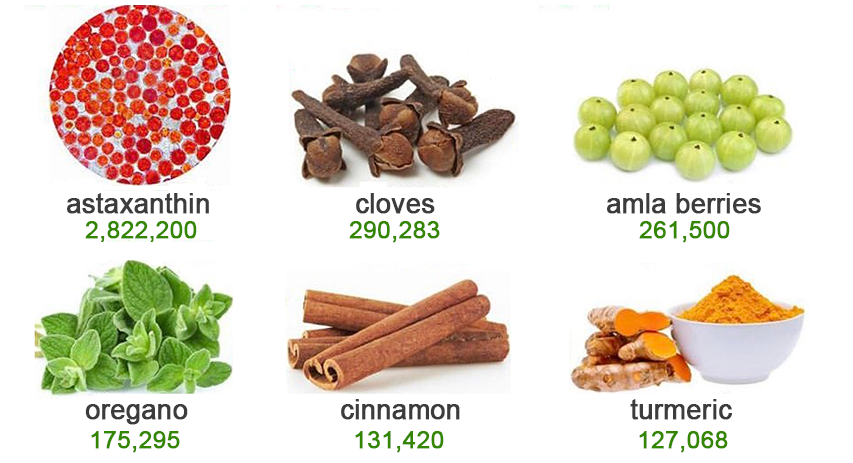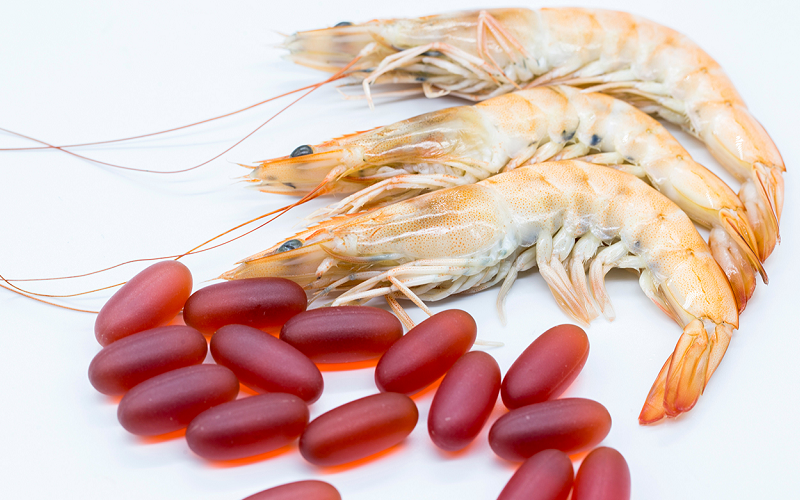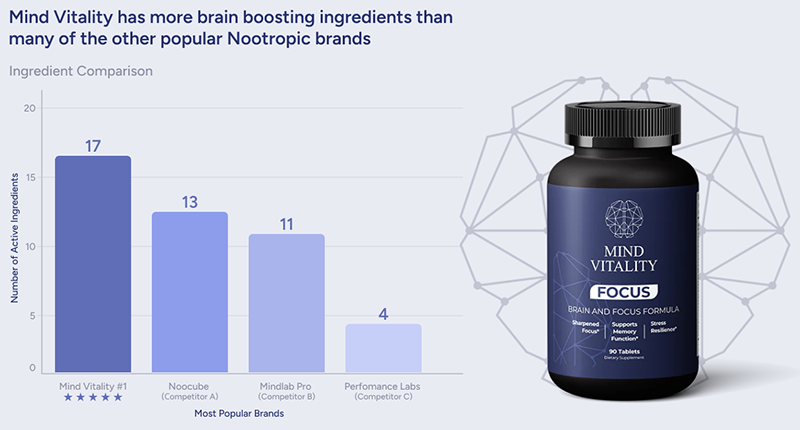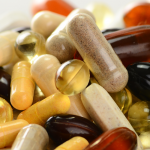Omega-3 fatty acids are polyunsaturated fatty acids with many health benefits. For decades fish oil has been the omega-3 nutritional supplement of choice. In recent years, though, krill oil (processed from krill, a small shrimp-like crustacean), has become the new favorite source for the important omega-3s eicosapentaenoic acid (EPA) and docosahexaenoic acid (DHA). Krill oil omega-3s have better bioavailability than omega-3s from fish oil, and krill oil also contains a super powerful antioxidant not found in fish oil — astaxanthin.
Contents
Omega-3 Fatty Acids
Before getting into the nitty gritty of the nutrients mentioned in the title of this article — krill oil, fish oil, and astaxanthin — we need to discuss the main reason fish oil and krill oil are very popular nutritional supplements. That reason is omega-3 fatty acids.
Types of Omega-3s
Omega-3s are members of the polyunsaturated fatty acids (PUFA) family of fats. Polyunsaturated fats get that name from their chemical makeup — they are fat molecules that have more than one unsaturated carbon bond (referred to as a double bond).
Omega-3s are fatty acids that your body can’t produce on its own. To satisfy your body’s needs for omega-3s you’ve got to include them in your diet — mainly by way of plant oils and fish. So in addition to being polyunsaturated fatty acids, omega-3s are also essential fatty acids (EFA).
There are eleven types of omega-3 fatty acids, but of those, three are far and away considered the most important:
- Alpha-linolenic acid (ALA) This omega-3 is found mainly in plants, particularly in oils such as canola, soybean, and flaxseed oils. ALA is the most common omega-3 fatty acid in a person’s diet.
- Eicosapentaenoic acid (EPA) EPA is found mostly in seafood, including fatty fish and algae.
- Docosahexaenoic acid (DHA) Like EPA, the main source of DHA is seafood.
Omega-3 Health Benefits
The omega-3 fatty acids are truly building blocks for cells — they help to define the structure of cell membranes. Cells have proteins that are referred to as cell receptors. These receptors bind to signaling molecules sent by other cells in order to be triggered to perform some action. Omega-3 fatty acids contribute to cell receptors functioning properly. Cell signalling actions are plentiful, from having anti-inflammatory anti-blood-clotting effects to hormone production to brain development — so the list of omega-3 benefits is extensive.
- Reduces inflammation
- Reduces liver fat
- Improves join and bone health
- Limits age-related mental decline and Alzheimer’s disease
- May help to prevent some cancers
- Fights autoimmune diseases such as rheumatoid arthritis and lupus
- Reduces asthma in children
- May improve quality of sleep
- Lessens anxiety and depression
- Improves eye health
- Reduces menstrual pain
- Promotes brain development during pregnancy and infancy
- Limits risk factors for heart disease
- Improves skin elasticity
- Reduces attention-deficit/hyperactivity disorder (ADHD) in children
Krill Oil as a Source of Omega-3 Fatty Acids
When it comes to omega-3 fatty acid supplements, fish oil and krill oil are the most popular. Both are high in the important eicosapentaenoic acid (EPA) and docosahexaenoic acid (DHA) fatty acids, but absent of the other important omega-3 fatty acid alpha-linolenic acid (ALA). The lack of ALA isn’t an issue though — almost everyone in the United States gets enough ALA from the foods they eat. The same isn’t true of EPA and DHA — thus the reason for supplementing.
In the past, fish oil has always been the go-to source for omega-3 fatty acids. For good reason — it’s loaded with DHA and EPA omega-3s. In the past decade, though, krill oil has gained — and continues to gain — a large following. Many people feel krill oil is a superior choice for omega-3s, for the reasons listed below.
Krill are small reddish-color crustaceans, ranging in length from 1/2 inch up to 6 inches. All crustaceans have a segmented body with an exoskeleton (hard exterior), jointed limbs, and antennae. Examples of crustaceans are lobsters, crabs, and shrimp. Krill are often mistakenly identified as shrimp — understandably because the two types of crustaceans are very similar. Krill are most abundant in the cold waters of the Arctic.
Krill Oil and Phospholipids
Lipids are molecules that include waxes, fats, and some vitamins. Triglycerides are a lipid — they’re the most common type of fat in humans. Triglycerides come in a number of fats you eat, including butter and many oils. Triglycerides are also made by your body — your body can convert excess calories into triglycerides that get stored within fat cells, available as an energy source. Phospholipids are another type of lipid. Phospholipid molecules are the main component of cell membranes.
The EPA and DHA omega-3 fatty acids found in fish oil are in the form of triglycerides. The EPA and DHA omega-3 fatty acids found in krill oil are in the form of phospholipids. This is a key distinction between fish oil and krill oil, and is one of the main reasons krill oil is a preferable source of omega-3s.
The form EPA and DHA take — triglycerides or phospholipids — is important because it dictates how these omega-3s are delivered in the body. Omega-3s in triglyceride form (fish oil) need to be processed in the liver before they can be taken up by the cells and used by the body. Omega-3s in phospholipid form (krill oil), on the other hand, are carried directly into the blood and incorporated into cells as they’re carried to the organs and tissues that need them the most.
Krill Oil and Astaxanthin
Carotenoids are red, orange, and yellow pigments that are synthesized — a compound built, or created, by chemical reactions involving more basic substances) — by plants. Carotenoids are responsible for the rich coloring of many fruits and vegetables, such as the red of red bell peppers and the orange of carrots.
Carotenoids, a class of phytonutrients (“plant chemicals”), assist in a plant’s absorbing of light for photosynthesis — the use of sunlight to synthesize foods from carbon dioxide and water. Carotenoids are also powerful antioxidants — substances that fight free radicals (single oxygen atoms that can damage cells by reacting with other molecules).
Of the hundreds of carotenoids the most well-known is beta-carotene (β-carotene). Beta-carotene is probably so well-known because it is the most abundant carotenoid in our bodies, and because it is converted by the body to vitamin A (so many people equate beta-carotene with actually being vitamin A).
Astaxanthin is another of the hundreds of carotenoids. Like other carotenoids, its been overshadowed by beta-carotene, so there’s a good chance you’ve never heard of it. But you, and everyone else that’s at all concerned or interested in health, definitely need to know about it!

Being a carotenoid, astaxanthin is a pigment — it has a naturally deep red color. Algae produce and accumulate astaxanthin naturally. As a food source for many marine species, the pigment transfers to these animals. Krill live off of algae, so krill themselves contain a large amount of astaxanthin — it’s also where krill get their red coloring.
Many marine species eat algae, so in addition to krill, astaxanthin is also responsible for the coloring of several other animals. The red in lobsters, shrimp, and crabs, for example, is all due to the astaxanthin these creatures consume. The pigment also can move up the food chain and affect larger animals that eat these smaller algae-eating species. For instance, the coloring of salmon and flamingos comes from both astaxanthin-rich plankton they eat as well as from small fish and crustaceans they also consume.
Astaxanthin Health Benefits
What makes astaxanthin such an important nutrient is its power as an antioxidant. All carotenoids are antioxidants, but astaxanthin takes things to a whole new level. Consider the oxygen radical absorbance capacity (ORAC) table — a measure of antioxidant capacity. This table is used to make comparisons of the antioxidant powers of various nutrients.
Astaxanthin has an ORAC value of 2,822,200, making it almost 300 times as potent as wild blueberries — one of the most popular (and presumed most powerful) antioxidant-rich foods. Astaxanthin’s ORAC value also reveals that it has antioxidant properties 6,000 times more potent than vitamin C, and at least 500 times more potent than vitamin E.

In addition to being a powerful antioxidant, astaxanthin provides several other health benefits.
- Supports a Healthy Heart Astaxanthin helps reduce low-density lipoproteins (LDL, the “bad” cholesterol) and raise high-density lipoproteins (HDL, the “good” cholesterol), and also lowers high blood pressure.
- Protects Skin From UV Damage Taking supplements or consuming foods rich in astaxanthin may also help to protect your skin from ultraviolet (UV) damage. Astaxanthin accumulates in the dermis and epidermis layers of your skin, which is a good thing — the astaxanthin helps block UV penetration, and also reduces existing damage.
- Reduces Inflammation Astaxanthin reduces inflammation by acting on free radicals to reduce proteins that can cause inflammatory diseases like diabetes, heart disease, rheumatoid arthritis, and celiac disease.
- Supports the Immune System Astaxanthin has positive effects on your immune system due to its ability to activate white blood cells (T-cells) that attack foreign cells based on antigen markers, and natural killer (NK) cells that work at a fast speed to stop health-weakening invasions.
- Supports Cognitive Health Carotenoids in general have a positive effect on the brain by reducing the risks for neurodegenerative diseases. Astaxanthin, being a smaller molecule that can cross the blood-brain barrier, adds extra brain protection. Recent human clinical studies showed that test subjects taking astaxanthin experienced significant reductions in depression, tension, and confusion, and improvements in mood, and verbal and visual memory.
Conclusion
Omega-3 fatty acids are polyunsaturated fatty acids (PUFA) that your body gets only from your diet. Omega-3s are the building blocks of cells and have been shown to have many health benefits including reducing inflammation, improving bone and joint health, preventing some cancers, and fighting autoimmune diseases.
Two of the most important omega-3s — eicosapentaenoic acid (EPA) and docosahexaenoic acid (DHA) — are plentiful in fish oil and krill oil. While both fish oil and krill oil and excellent nutritional supplements, krill oil (processed from small shrimp-like krill crustaceans) is superior because its omega-3s are in the form of phospholipids — a type of lipid (fat) that can be taken up directly by cells and used by the body. Additionally, krill oil naturally contains astaxanthin, a carotenoid (pigments that assist in plant photosynthesis) that is one of the most powerful antioxidants.





